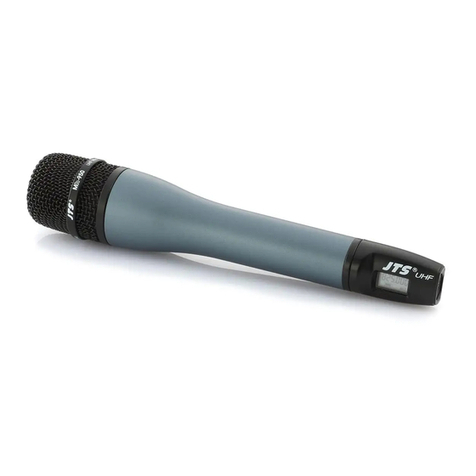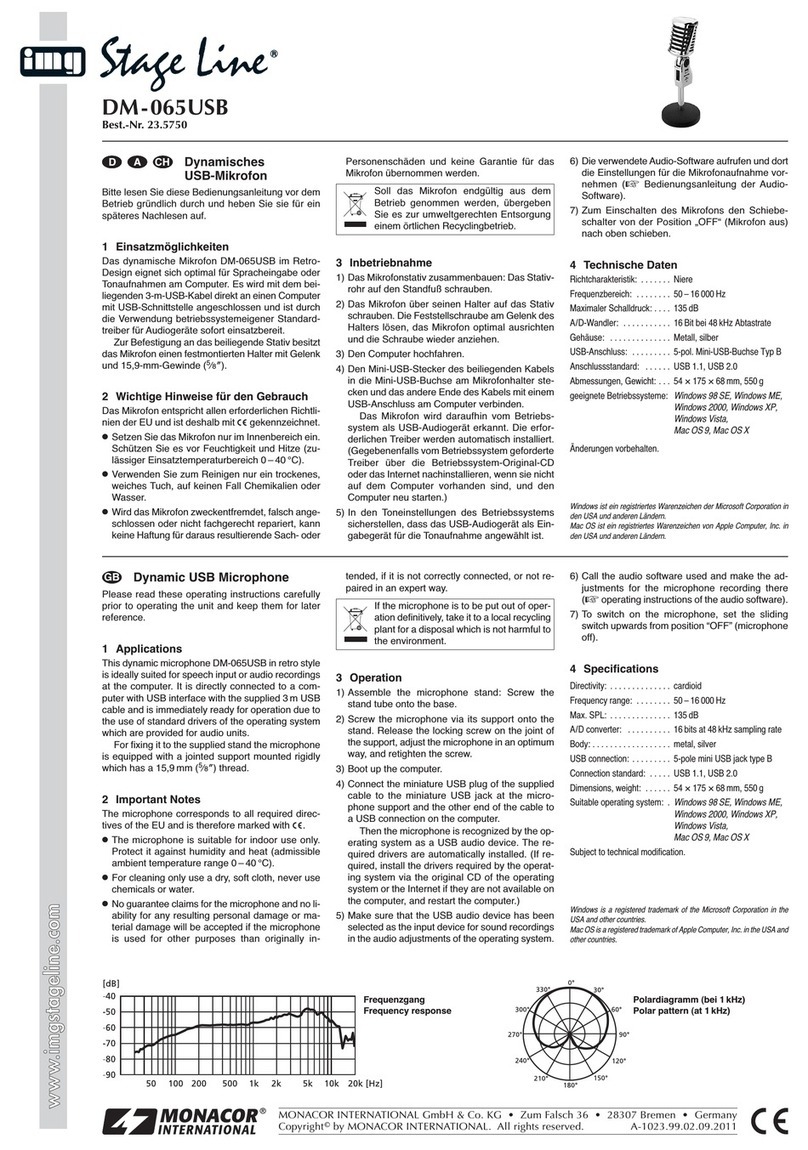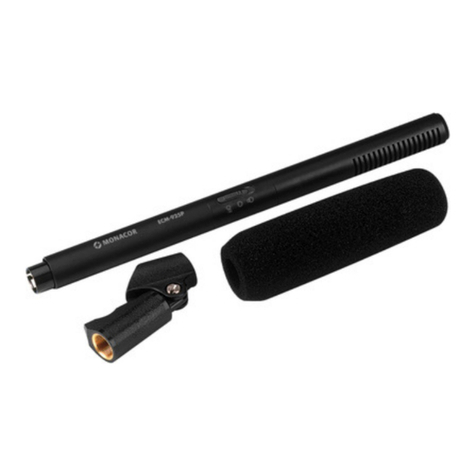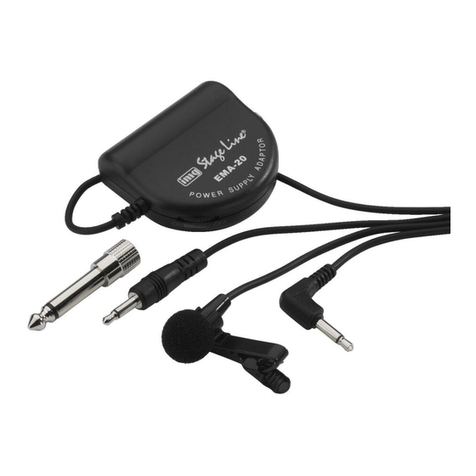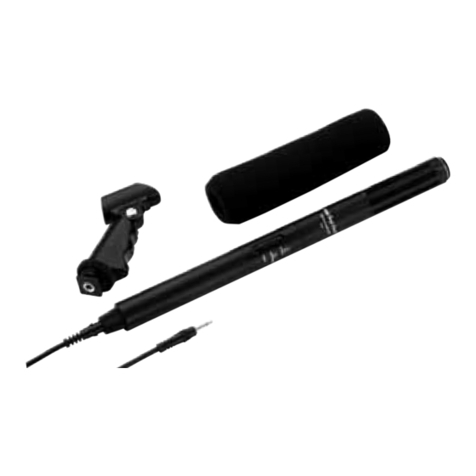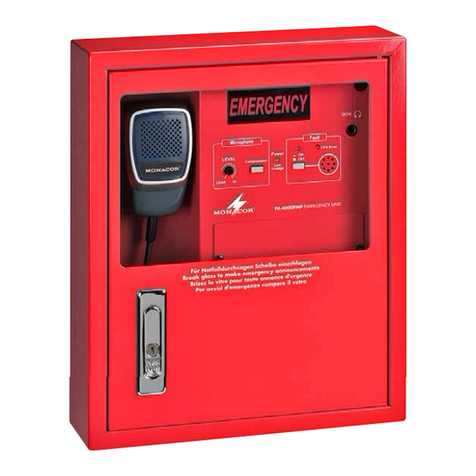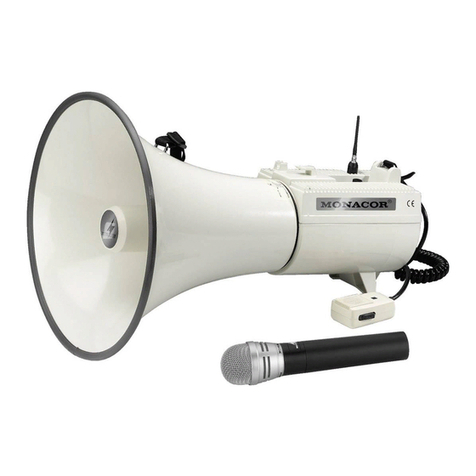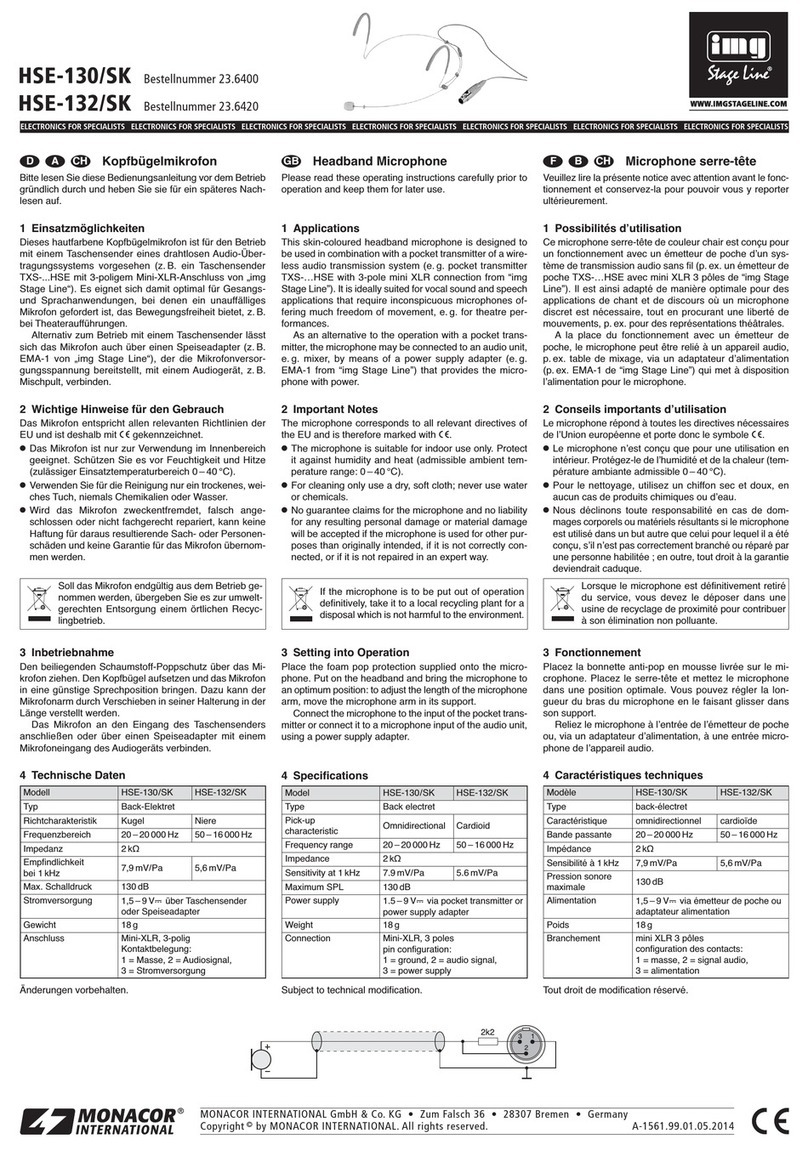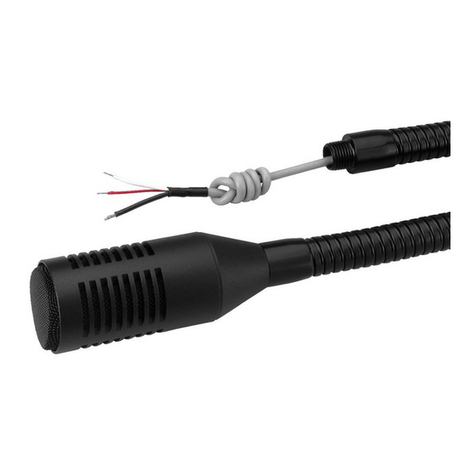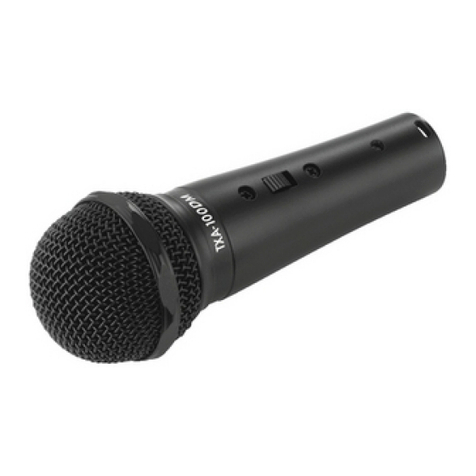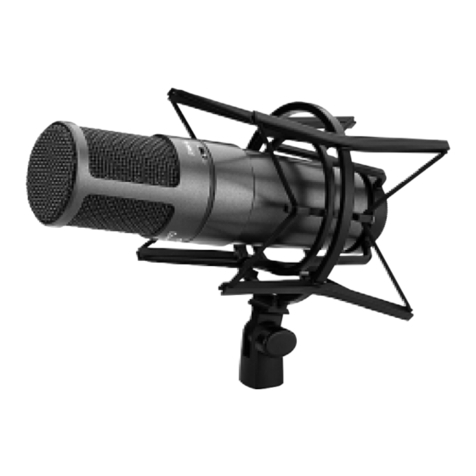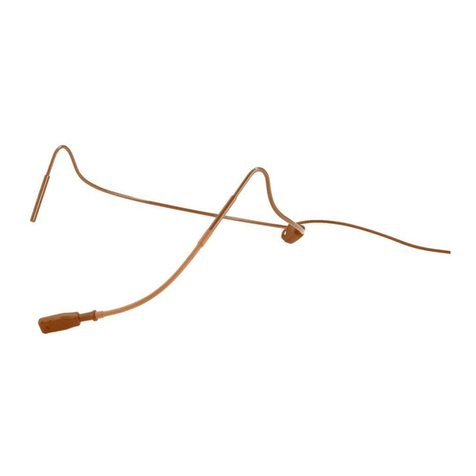Elektret-Overhead-Mikrofon
Einsatzmöglichkeiten
Das Elektret-Overhead-Mikrofon ECM-280 ist für
den Einsatz auf der Bühne vorgesehen und eignet
sich optimal für die Schallabnahme am Schlagzeug
(z.B. Becken, Hi-Hat) und für Gesangs- und
Sprachanwendungen.
Dem Mikrofon liegt ein Halter mit 16-mm-Gewin-
de (5/8") bei, der mit einem abschraubbaren Adap-
ter mit 9-mm-Gewinde (3/8") ausgestattet ist. Zum
Lieferumfang gehört außerdem ein 6-m-Anschluß-
kabel (nicht bei dem Mikrofonset DRUM-1SET).
Hinweise für den sicheren Gebrauch
Das Mikrofon entspricht der EMV-Richtlinie für elek-
tromagnetische Verträglichkeit 89/336/EWG.
●Das Mikrofon ist nur zur Verwendung im Innen-
bereich geeignet. Schützen Sie es vor Feuchtig-
keit und Hitze (zulässiger Einsatztemperaturbe-
reich 0–40°C).
●Verwenden Sie für die Reinigung nur ein trocke-
nes, weiches Tuch, auf keinen Fall Chemikalien
oder Wasser.
●Wird das Mikrofon zweckentfremdet, falsch an-
geschlossen oder nicht fachgerecht repariert,
kannfüreventuelleSchädenkeineHaftungüber-
nommen werden.
●Werfen Sie verbrauchte Batterien nicht in den
Hausmüll, sondern geben Sie sie nur in den Son-
dermüll (z.B. Sammelbehälter bei Ihrem Einzel-
händler).
●Soll das Mikrofon endgültig aus dem Betrieb
genommen werden, übergeben Sie es zur Ent-
sorgung einem örtlichen Recyclingbetrieb.
Inbetriebnahme
1) Das Mikrofongehäuse öffnen: Die Schraubkappe
(unterer Gehäuseteil) durch Drehen gegen den
Uhrzeigersinn abschrauben.
2) Eine1,5-V-Mignon-Batterie (AA)gemäß demAuf-
druck im Batteriefach einsetzen. Wird das Mi-
krofon längere Zeit nicht benutzt (z.B. länger als
eine Woche), sollte die Batterie herausgenom-
men werden, um Schäden durch ein eventuelles
Auslaufen der Batterie zu vermeiden.
3) Den Schalter neben dem Batteriefach je nach
Anwendung einstellen:
bei Gesangs-/Sprachanwendungen:
auf Position „V“ („voice“)
bei Schallabnahme vom Instrument:
auf Position „M“ („music“)
4) Die Schraubkappe des Gehäuses wieder auf-
schrauben.
5) Den beiliegenden Mikrofonhalter auf ein Mikro-
fonstativschrauben:Besitzt dasStativein 16-mm-
Gewinde (5/8"), die Adapterschraube des Halters
entfernenund den Halter direkt aufschrauben. Bei
einem 9-mm-Gewinde (3/8") am Stativ den Halter
über die Adapterschraube befestigen. Das Mikro-
fon in den Halter schieben.
6) Das Mikrofon an einen XLR-Mikrofoneingang
des Audiogerätes (z.B. Mischpult, Verstärker)
anschließen.
Technische Daten
Typ: . . . . . . . . . . . . . . . . Elektret-Mikrofon
Richtcharakteristik: . . . . Niere
Frequenzbereich: . . . . . 100–16000Hz
Empfindlichkeit: . . . . . . . 4mV/Pa bei 1kHz
Impedanz: . . . . . . . . . . . 600Ω
Max. Schalldruck: . . . . . 120dB
Stromversorgung: . . . . . 1,5V-Mignon-Batterie
(AA)
Einsatztemperatur: . . . . 0–40°C
Abmessungen: . . . . . . . Ø 26/24mm x 187mm
Gewicht: . . . . . . . . . . . . 100g
Anschluß: . . . . . . . . . . . XLR, symmetrisch
Laut Angaben des Herstellers.
Änderungen vorbehalten.
Electret Overhead
Microphone
Applications
The electret overhead microphone ECM-280 is pro-
vided for stage applications and ideally suited for
the sound pick-up at the drums (e.g. cymbals, hi-
hat) and for vocal sound and speech applications.
The microphone is supplied with a support with
a 16 mm (5/8") thread. This support is equipped with
an adapter to be screwed off, provided with a 9mm
(3/8") thread. In addition, the scope of supply in-
cludes a 6m connection cable (not in case of micro-
phone set DRUM-1SET).
Safety Notes
The microphone corresponds to the directive for
electromagnetic compatibility 89/336/EEC.
●The microphone is only suitable for indoor appli-
cations. Protect it against humidity and heat (ad-
missible ambient temperature range 0–40°C).
●For cleaning only use a dry, soft cloth, by no
means chemicals or water.
●If the microphone is used for purposes other than
originally intended, if it is not connected correctly
or not repaired in a qualified way, no liability can
be assumed for possible damage.
●Do not put exhausted batteries into the domestic
rubbish, but only take them to a special waste
disposal (e.g. collective container at your re-
tailer).
●If the microphone is to be put out of operation
definitively, it must be disposed of in a local re-
cycling plant.
Setting into Operation
1) Open the microphone housing: screw off the
screw cover (lower housing part) by turning it
counterclockwise.
2) Insert a 1.5V battery of AA size according to the
imprint in the battery compartment . If the micro-
phone is not used for a longer time (e.g. more
than a week), it is recommended to take out the
battery to avoid damage by possible battery leak-
age.
3) Adjust the switch beside the battery compart-
ment according to application:
in case of vocal sound/speech applications:
to position “V” (“voice”)
in case of sound pick-up of the instrument:
to position “M” (“music”)
4) Screw on the screw cover of the housing again.
5) Screw the supplied microphone support on a
microphone stand: if the stand is provided with a
16mm (5/8")thread, remove the adapter screw of
the support and screw on the support directly. In
case of a 9mm (3/8") thread at the stand, fix the
support via the adapter screw. Slide the micro-
phone into the support.
6) Connect the microphone to an XLR microphone
input of the audio unit (e.g. mixer, amplifier).
Specifications
Type: . . . . . . . . . . . . . . . electret microphone
Pick-up pattern: . . . . . . . unidirectional
Frequency range: . . . . . 100–16000Hz
Sensitivity: . . . . . . . . . . . 4mV/Pa at 1 kHz
Impedance. . . . . . . . . . . 600Ω
Max. sound pressure: . . 120dB
Power supply: . . . . . . . . 1.5V battery of AA size
Ambient temperature: . . 0–40°C
Dimensions: . . . . . . . . . Ø 26/24mm x 187mm
Weight: . . . . . . . . . . . . . 100g
Connection: . . . . . . . . . . XLR, balanced
According to the manufacturer.
Subject to change.
GB
Copyright©by MONACOR®International GmbH & Co. KG, Bremen, Germany. All rights reserved. 12.00.03
®
ECM-280
Best.-Nr. 23.2360
wwwwww..iimmggssttaaggeelliinnee..ccoomm
D
A
CH
1.5 V
